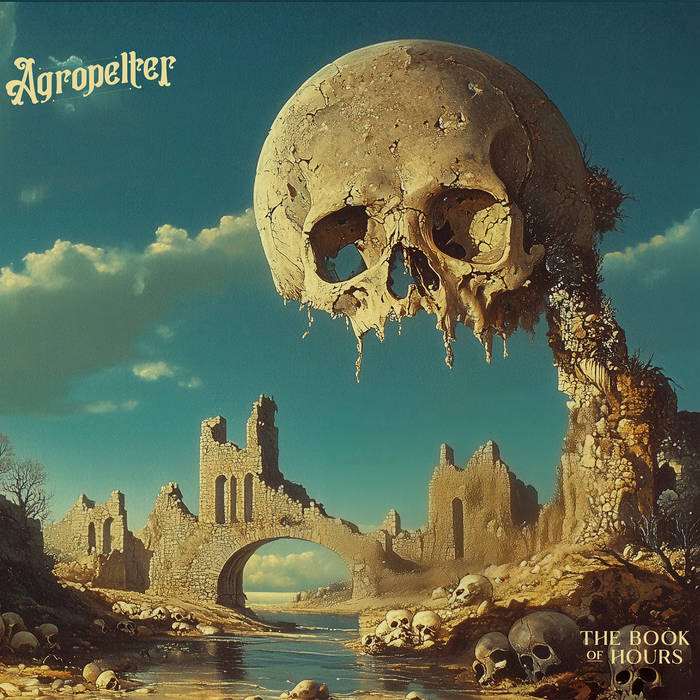
Review | Agropelter – The Book Of Hours
The Laser's Edge
A debut that strikes like lightning, ‘The Book of Hours’ is a full-blown cinematic pilgrimage across the winding spires of progressive rock’s vast discography. Agropelter is the brainchild of Norwegian creative force Kay Olsen, and he doesn’t walk the path of the majority but rather carves vivid frescoes in sonic pillars of the genre’s past. With a toolkit of Mellotron, Hammond organs, ARP, cembalo, Minimoogs and Taurus bass pedals Olsen run rampant. Olsen plays all guitars, bass, church organ, and keyboard, and injects mysticism into the fold.
STORIES THAT NEED NO WORDS
He tells stories that need no words. Each track is a chapter in a larger story, illuminated by flickering torchlight and drenched in analogue admiration. This album is pure and displays devotion to the art of sound.
,,Flute of Peril” opens the gates with a melancholic touch of bitterness in its core. A flute glides over the track’s building cinematic tension, teasing something mysterious yet playful. Layers of vintage synths breathe underneath like an ancient machine awakening. The rhythm section is patient but precise, offering a heartbeat to the unpredictable melody lines. The acoustic guitar strolls in fine melodic pitch, slicing the song’s darker textures. It’s as eccentric as it breathes ominous, a delicious contradiction setting the tone for the journey ahead.
,,Levitator”, that lifts from the earth immediately. Agropelter channels the gravitational push-and-pull of jazz fusion without losing the compass of composition. The drums twitch and swirl, its dynamics in playful mode of time changes and rhythm shifts, guiding organ lines that rise like mist over the colossal ruins of the past. Synth cascades stretch toward the sky while the bass anchors the track terra firma with a repetitive chordal discharge. Keys raining atop the guitars, telling their story, constantly replaced by synth melodies.
The vibe from ,,One of these Days” pops to mind, just when Olsen shifts into his unique territory. The lush middle section breathes are into the restrained lift, adding a glorious edge underneath the guitar and key swirls. It’s an ascension piece, crackling with tension yet glowing with restraint. The resonance of its tapestry as a rare dance of chaos and control.
A GHOST STORY
Midway through, ,,Burial Mound” emerges like a ghost story whispered through centuries. There’s a cinematic melancholy here, but never inert. The Mellotron weeps gently in the background, and you realize this is no ordinary instrumental. Its motif drones, tender and fragile, with guitars plucking lush and ethereal. Drum rattles into the end and Gregorian chants arse. Remote, delicate. The music that mourns, reflects, and ultimately uplifts.
MULTI-PART SUITE
But it’s the multi-part suite ,,The Book of Hours” itself that seals the album’s grandeur. Opening with ‘part I’, the 11-minute prog piece touches all progressive terrain. With a sturdy throbbing bass and keys and synths hovering, the song gradually lifts. The Hammond smothered, time starts ticking and drum shifts gear. Guitars start to pick up in its lift, with keyboards and synth elevating. Keenly mixed into the front, everything starts to well like Eloy on steroids, with Yes and Peter Hammill nodding in the sideline.
The pull of the song is tremendous; the sonic output evokes visions. When the song breaks root midway, the grand piano shifting the dynamics with Keith Emerson’s classical playing coming to mind. Its extended notes blast into swirling mellotron keys with the drums switching to polyrhythms, with the song fusing its previous elements for its finale, bridging into the neo-prog tinged second chapter with its lush guitars, drizzling keys, and elemental melodies.
EPIC FINALE
This epic finale is not just a track; it’s a cathedral walk through time. Themes recur like colourful stained-glass patterns, refracting differently each time light passes through. Its scattered colors and light impact on the vibrational frequence of the story transmitted. Organ tones swell like choirs of the forgotten, drums echo off invisible walls, and synths chase each other through a labyrinth of structure and space. ‘Part III’ is a testament in its own right. There’s patience here, a reverence for build-up, an understanding of climax. And when it finally erupts, it’s not into bombast, but into a majestic orbit. It is a musical amen echoing into silence. Jabbing choirs and keys pack the intensity to keep you on edge.
The dynamics of this section lead into the Grande finale of ‘part IV’, touching all cornerstones of Olsen’s vision and his idols. Playful aptitudes are intertwined with classical piano and flute, the dazzling note runs are layered atop impressive time changes and dynamic drum interplay. The medieval touch adds a different flavour before the song slowly goes skybound again. The songs dying notes, long lasting…. With a glorious subnote, echoing the culmination of this sonic journey and its visions distilled.
AGROPELTER – THE CONCLUSION
Agropelter doesn’t shout to be heard, it whispers with authority. ‘The Book of Hours’ is a thought-evoking album standing out in an era of overexposure. It’s an analog beacon glowing quietly in a digital storm, reigniting the sonic past of classical music blend with touches of Pink Floyd, King Crimson and Eloy. It recalls the meticulous vision of these greats, but it breathes with its own pulse. This isn’t just nostalgia, it is a resurrection of listening music and headphones. Olsen transmits his message with passion and devotion, and this sonic book needs its hours.
For fans who live and breathe progressive rock’s deeper dimensions, this debut by Agropelter is a revelation.
Everyone else? Well, the hour has come.
Release date: 25 July 2025





Comments